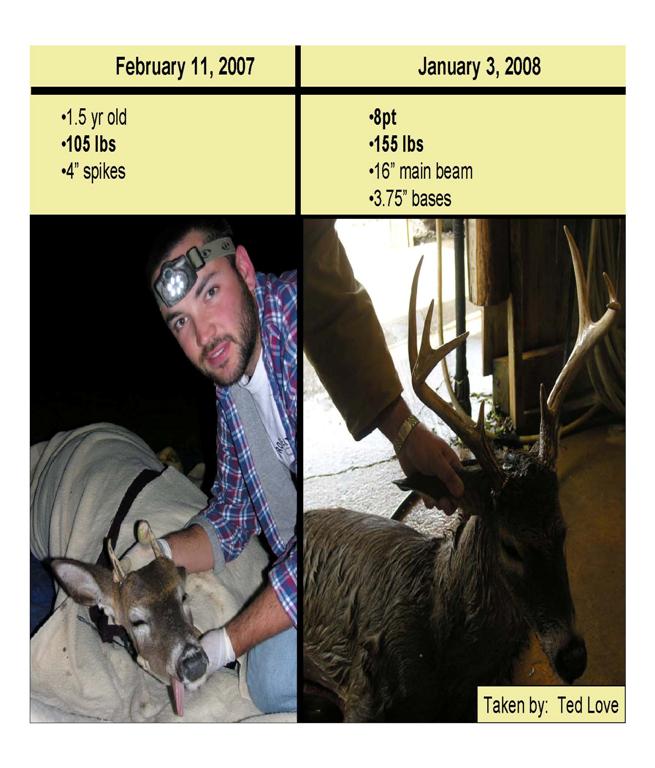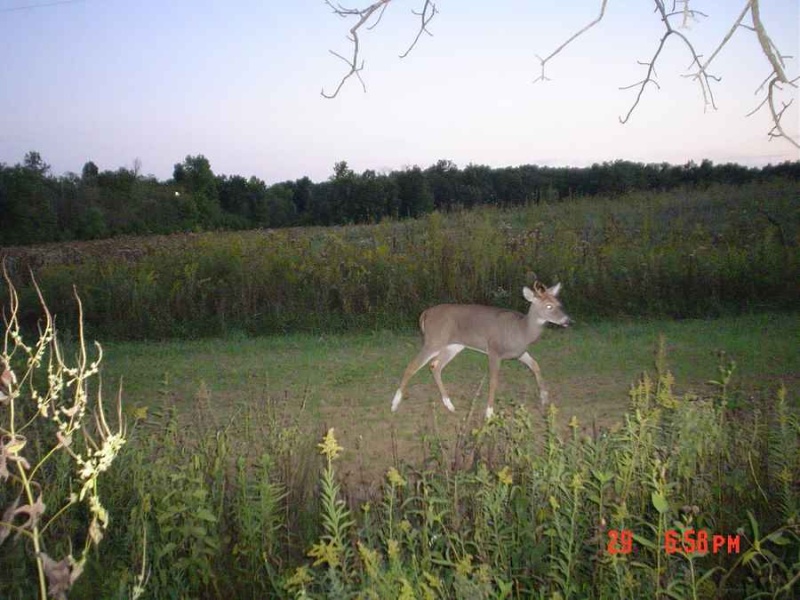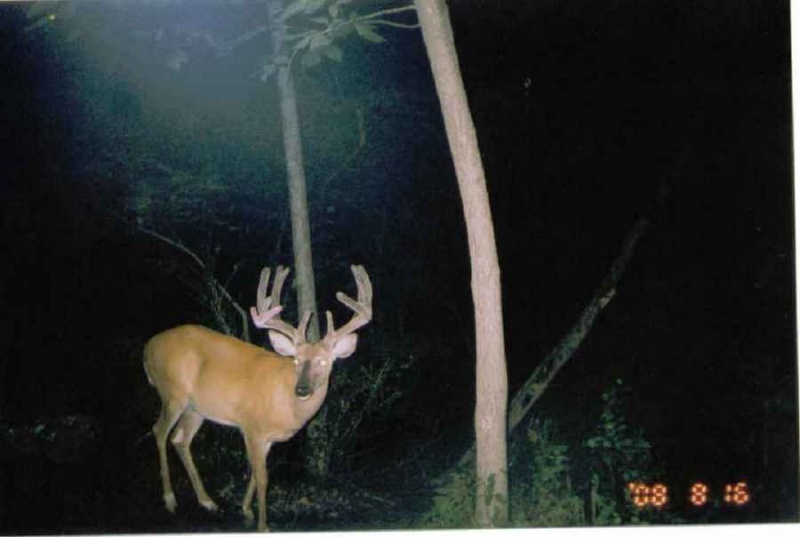Shouldn't they be bigger?
#31
ORIGINAL: npaden
You do realize that the infamous Kerr study is based on deer that have been raised in an research area that is a whopping 16 acres and the breeding pens are less than an acre each. These deer have been under controlled breeding since 1974. If you are after those kind of results you could fence off your backyard and buy a stud buck and a few proven does and shoot your own 200" deer any time you felt like it.
You do realize that the infamous Kerr study is based on deer that have been raised in an research area that is a whopping 16 acres and the breeding pens are less than an acre each. These deer have been under controlled breeding since 1974. If you are after those kind of results you could fence off your backyard and buy a stud buck and a few proven does and shoot your own 200" deer any time you felt like it.
I'm not arguing that in a completely controlled environment that you can't improve the genetics by extensive culling. You most certainly can and the Kerr Study proves that. I'm saying that culling is not a viable alternative in a free range environment and studies have shown this.
In the King Ranch study they did have a control group where they did not practice culling. Under the same environmental conditions that population actually improved in average antler size during the same 6 years. These are degreed wildlife biologists doing these studies, not random individuals. They might actually know what they are doing.
Further, can anyone say 6 years is enough time to conclusively prove culling does not work?
Here are some online articles that I found on the QDMA site.
Here's the full article that I pulled the quote in my previous post from - http://www.qdma.com/articles/details.asp?id=124
Here's another article on culling - http://www.qdma.com/articles/details.asp?id=84
Here's another article on spikes specifially. It was written in part by Dr. James Kroll (sometimes referred to as "Dr. Deer") - http://www.qdma.com/articles/details.asp?id=23
Here's the full article that I pulled the quote in my previous post from - http://www.qdma.com/articles/details.asp?id=124
Here's another article on culling - http://www.qdma.com/articles/details.asp?id=84
Here's another article on spikes specifially. It was written in part by Dr. James Kroll (sometimes referred to as "Dr. Deer") - http://www.qdma.com/articles/details.asp?id=23
The key in free ranging spikes is that you really don't know why they are a spike as a yearling. They could have the genetics to become a 160" deer at 4 years old and just been born late or born to a young mother with poor lactation or a number of other possibilties. They could have the genetics to be a 120" deer at 4 years old too. In a controlled pen raised environment where you control the timing of the breeding and their entire food supply you can have pretty decent assurance that a 1.5 year old spike is a result of genetics and those studies are valid on pen raised deer. But not on free ranging deer. You could actually make a better argument on culling a 120" 4 year old deer than culling a spike yearling but even then it is not recommended on free ranging deer.
Here's one of the collared deer:

Here's a link to the thread on the QDMA forum showing some of the other radio collared bucks - http://www.qdmaforums.com/showthread.php?t=13582
The spike above was by far the smallest buck collared both in weight and antler size when it was originally captured but had nearly caught up when he was shot a year later. Given another year it would have probably caught up completely.

Here's a link to the thread on the QDMA forum showing some of the other radio collared bucks - http://www.qdmaforums.com/showthread.php?t=13582
The spike above was by far the smallest buck collared both in weight and antler size when it was originally captured but had nearly caught up when he was shot a year later. Given another year it would have probably caught up completely.
Here's another set of pictures of a spike that a fellow QDMA member has taken trail camera pictures of over the last several years. He was able to keep track of the deer year to year based on the white socks on his feet.
Here is a picture of him in 2005 as a yearling spike (okay he is technically a 3 point but for all intents and purposes he would have been considered undesirable under the Kerr study):

Here his is 3 years later as a mature 4 year old.

P.S. - These aren't the only pictures this guy has of this deer. He has watched it mature over the years and is 100% positive that it is the same deer.
Here is a picture of him in 2005 as a yearling spike (okay he is technically a 3 point but for all intents and purposes he would have been considered undesirable under the Kerr study):

Here his is 3 years later as a mature 4 year old.

P.S. - These aren't the only pictures this guy has of this deer. He has watched it mature over the years and is 100% positive that it is the same deer.
#32
The place I hunt was managed poorly up until the 1980's. The old rules were no does were shot, and spikes were not culled. Over half of the buck population did not have brow tines.
In 1994, we started filling doe tags and culling spikes. A 5.5 spike was culled in 1995, along with several spikes that were 2.5 or older. For the first 5 or so years, very few mature bucks were taken, because so many tags were filled with culls (1 buck county).
I've seen one spike the last two years, and no mature cull bucks. Size and quality of the bucks has gone up noticeably, with all hunters able to fill their tags with quality deer. This is on approximately 700 acres free range.
In 1994, we started filling doe tags and culling spikes. A 5.5 spike was culled in 1995, along with several spikes that were 2.5 or older. For the first 5 or so years, very few mature bucks were taken, because so many tags were filled with culls (1 buck county).
I've seen one spike the last two years, and no mature cull bucks. Size and quality of the bucks has gone up noticeably, with all hunters able to fill their tags with quality deer. This is on approximately 700 acres free range.
#33
Typical Buck
Join Date: Feb 2003
Location: Cambridge Ohio USA
Posts: 744
[blockquote]quote:
Is it 1980 again? It's been proven over, and over, and OVER that culling deer based upon antler traits is worthless. It's nothing more than a advertising gimmick used by deer "ranch" owners on television shows. I guess some people still buy it.[/blockquote]
That has never been proven.
#36
For anyone actually interested in learning something about the subject, next weeks episode of Quality Whitetails Television on the Outdoor Channel is on this exact subject.
#37
We hunt relatively poor soils (Upland Soils - NY) - but with OK Genetics. I've never seen a 2.5 year old spike taken in the 25 years I've hunted. I've seen some 2.5 year old 4 points, 5 points and 6 points. We hope that in our program - our 2.5 year old bucks will sport 8 points - but more often only about 1/2 do. Still.......... we never see Spikes at 2.5 years or older.
FH
FH
#38
Typical Buck
Join Date: Sep 2008
Location:
Posts: 751
First post. Couldnt help but laugh at this thread. No expert by far, but those'controled studies' are just that. Controled! Those spikes in the study are getting adequate nutrition, and are 'true spikes'. As many of the guys here have pointed out, free range spikes could be spikes for several reasons. Late birth, drought, low nutrition, etc. I dont know about you guys, but I dont think everything on my property is 16% protien. That study is probably spot on when dealing with 'true spikes' that are spikes genetically and not because of countless reasons previously mentioned throughout the thread. Like somebody else said. Some bucks are better than no bucks in most places. Most of us cant 'properly' manage anyway. I know Ive never had a 3 digitor 4 digit acreage to manage. I hunt 60 acres. I try to do my part, but for the most part, my neighbors have a say so as well, as to whether he makes it past a year and a half....and sadly enough (Ive done it before too in the early years), makes it past 0.5. That being said, we have had a loyal 6pter than needs to be taken out. I saw him as a 2.5 y/o and though gosh, he's going to make a good deer hopefully (by typical NC standards). Was 6pt and about 14" wide. Not big by national standards, but oh well. Well I didnt see him last year (3.5) but picked up his sheds this spring as a 3.5, appears to have same width, same tines, just a little heavier. Hard to manage a tract that small and kill the deer than need to be taken out. They get smart when theres a tom, d!ck, and harry every 400 yards in a tree during gun season around here.




